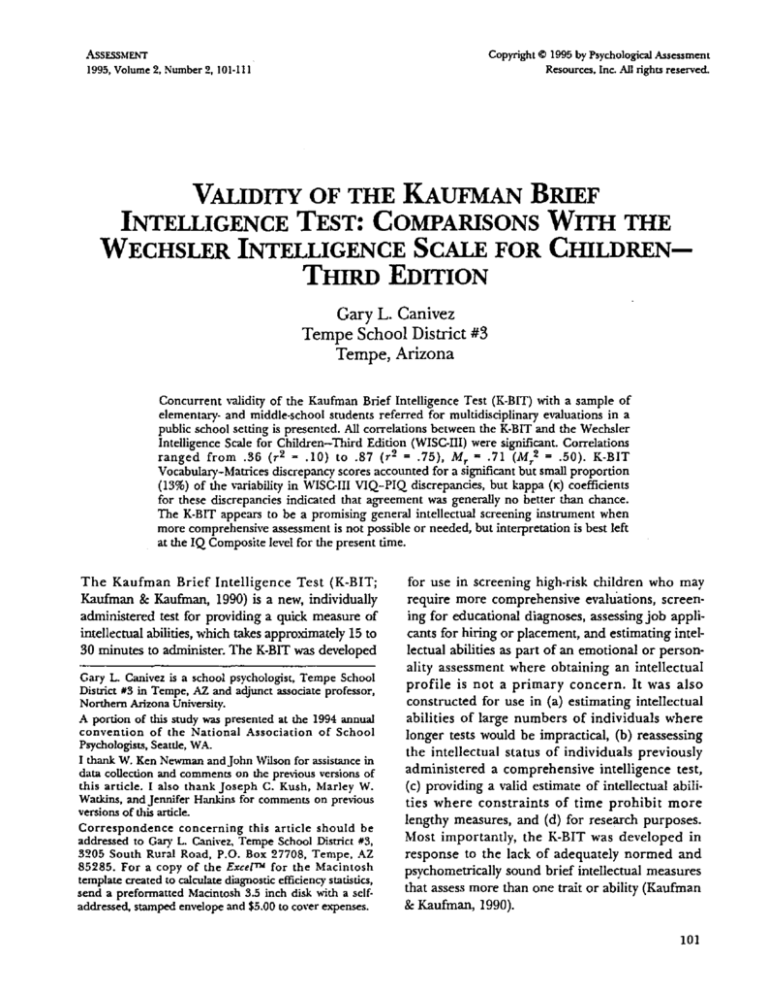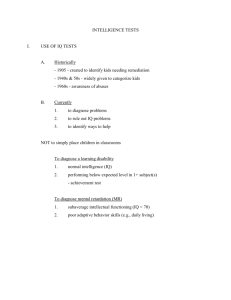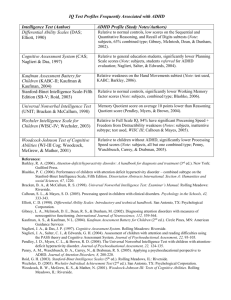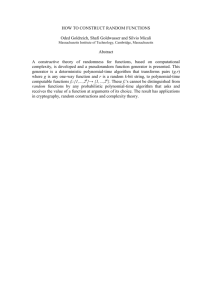
Copyright © 1995 by Psychological Assessment
AssESSMENT
1995, Volume 2, Number 2, 101-111
Resources. Inc. All rights reserved.
VALIDITY OF THE KAUFMAN BRIEF
INTELLIGENCE TEST: COMPARISONS WITH THE
WECHSLER INTEI.I.IGENCE SCALE FOR CHILDRENTHIRD EDITION
Gary L. Canivez
Tempe School District #3
Tempe, Arizona
Concurrent validity of the Kaufman Brief Intelligence Test (K-BIT) with a sample of
elementary· and middle-school students referred for multidisciplinary evaluations in a
public school setting is presented. All correlations between the K·BIT and the Wechsler
Intelligence Scale for Children-Third Edition (WISC-III) were significant. Correlations
ranged from .36 (r2 - .10) to .87 (r 2 = .75), M, = .71 (M,2 = .50). K·BIT
Vocabulary-Matrices discrepancy scores accounted for a significant but small proportion
(13%) of the variability in WISC.III VIQ-PIQ discrepancies, but kappa (K) coefficients
for these discrepancies indicated that agreement was generally no better than chance.
The K-BIT appears to be a promising general intellectual screening instrument when
more comprehensive assessment is not possible or needed, but interpretation is best left
at the IQ Composite level for the present time.
The Kaufman Brief Intelligence Test (K·BIT;
Kaufman & Kaufman, 1990) is a new, individually
administered test for providing a quick measure of
intellectual abilities, which takes approximately 15 to
30 minutes to administer. The K·BIT was developed
Gary L. Canivez is a school psychologist, Tempe School
District #3 in Tempe. AZ and adjunct associate professor,
Northern Arizona University.
was presented
A portion of this study
at the 1994 annual
convention of the National Associacion of School
Psychologists, Seattle, WA.
I thank W. Ken Newman and john Wilson for assistance in
data collection and comments on the previous versions of
this article. I also thank Joseph C. Kush, Marley W.
Watkins, and Jennifer Hankins for comments on previous
versions of this article.
Correspondence concerning this article should be
addressed to Gary L. Canivez. Tempe School District #3,
3205 South Rural Road, P.O. Box 27708, Tempe, AZ
85285. For a copy of the Excel™ for the Macintosh
template created to calculate diagnostic efficiency statistics,
send a preformatted Macintosh 3.5 inch disk with a self·
addressed, stamped envelope and $5.00 to cover expenses.
for use in screening high-risk children who may
require more comprehensive evaluations, screen·
ing for educational diagnoses, assessing job applicants for hiring or placement, and estimating intellectual abilities as part of an emotional or personality assessment where obtaining an intellectual
profile is not a primary concern. It was also
constructed for use in (a) estimating intellectual
abilities of large numbers of individuals where
longer tests would be impractical, (b) reassessing
the intellectual status of individuals previously
administered a comprehensive intelligence test,
(c) providing a valid estimate of intellectual abili·
ties where constraints of time prohibit more
lengthy measures, and (d) for research purposes.
Most importantly, the K-BIT was developed in
response to the lack of adequately normed and
psychometrically sound brief intellectual measures
that assess more than one trait or ability (Kaufman
& Kaufman, 1990).
101
Canivez
Concurrent validity has been supported by
comparisons between the K-BIT and the Test of
Nomerbal Intelligence (TONI; Brown, Sherbeno,
&Johnsen, 1990) and Slosson Intelligence Test
(SIT; Jensen & Armstrong, 1985) (Kaufman &
Kaufman, 1990). Correlation coefficients indicated good support for concurrent validity with
the Kaufman Assessment Battery for Children
(K-ABC; Kaufman & Kaufman, 1983), Wechsler
Intelligence Scale for Children-Revised (WISC-R;
Wechsler, 1974), and Wechsler Adult Intelligence
Scale-ReYised (WAIS-R; Wechsler, 1981) for
normal samples. K-BIT IQ Composite scores
correlated between .58 and .69 (M, = .63) with the
K-ABC Mental Processing Composite across three
age ranges. Correlations between the K-BIT IQ
Composite and WISC-R Full Scale IQ (r = .80) and
WAIS-R Full Scale IQ (r = .i5) also supported the
Yalidity of the K-BIT. In addition, the K-BIT
Vocabulary subtest correlated better with the
WISC-R and WAIS-R Verbal IQ than Performance
IQ (as would be expected) while the K-BIT
Matrices subtest correlated equally well with the
WISC-R and WAIS-R Verbal IQ and Performance
IQ (Kaufman & Kaufman, 1990). Prewett (1992a,
l 992b) has also found significant correlations
between the K-BIT and WISC-R for samples of
referred students and incarcerated juvenile delinquents, whereas Naugle, Chelune, and Tucker
(1993) found significant correlations with the
WAIS-R for a sample of patients receiving
neuropsychological evaluations.
The K-BIT Matrices subtest was included to assess
fluid/nonverbal ability, whereas the Vocabulary
sub tests (Expressive Vocabulary and Definitions)
assess crystallized/verbal ability. Horn and Cattell
( 1966) refer to crystallized abilities as skills heavily
dependent upon cultural experiences or direct
educational instruction, whereas fluid abilities are
reflected in culture-fair tasks and allow one to
adapt and function when faced with novel or unfamiliar problems. By including both verbal and
nom·erbal subtests (most brief intelligence tests
focus on one or the other), the K-BIT is able to
measure two very different skill areas which allow
the examiner to assess verbal-nom·erbal discrepancies as is done with the Wechsler scales (Kaufman
102
& Kaufman, 1990). Kaufman and Kaufman are
cautious about the interpretation of significant
(a= .05 or .01) Vocabulary-Matrices discrepancies
and recommend that practitioners first evaluate
the size of the discrepancy based upon a selected
"abnormal amount of scatter" observed in the
standardization sample; and second, "not attempt
to interpret the clinical, psychoeducational, or
neuropsychological implications" of such differences (p. 46). Kaufman and Kaufman recommended that such differences be used to formulate hypotheses about the individual's unique
pattern of abilities, which should be further investigated with a comprehensive assessment.
Unfortunately, to date, there appears to be only
one study, Naugle et al. ( 1993 ), investigating the
relationship between discrepancies obtained
between the Vocabulary and Matrices subtests of
the K-BIT and similar discrepancies on a comprehensive intellectual measure. The tenability of
hypotheses regarding the Vocabulary-Matrices
discrepancy predicting similar discrepancies in
comprehensive measures of intelligence is an
empirical question requiring study. Studies referenced in the K-BIT manual (Kaufman & Kaufman,
1990) comparing the K-BIT to the WISC-R and
the WAIS-R did not appear to examine the relationship between the K-BIT Vocabulary-Matrices
discrepancy and \\'ISC-R or WAIS-R Verbal
IQ-Performance IQ (VIQ-PIQ) discrepancy.
Prewett's (1992a, 1992b) analyses comparing the
K-BIT to the WISC-R also did not examine such
discrepancies. Naugle et al. found correlations
between the Vocabulary-Matrices discrepancy and
the WAIS-R VIQ-PIQ discrepancy ranged from
.23 to .59 across eight age ranges, while the correlation for the total sample was .46. If the K-BIT
Vocabulary-Matrices discrepancy is to be a useful
comparison, it must show acceptable concurrent
and predictive validity in relation to other
measures assessing verbal and nonverbal
discrepancies.
One year following the publication of the K-BIT,
the WISC-III (Wechsler, 1991) was published as a
revision of the WISC-R, and reflects updating of
materials as well as a new standardization sample
closely approximating the characteristics of I 988
Validity of the Kaufman Brief Intelligence Test
United States Census data on selected demographic
variables. Although the K-BIT manual presents
studies examining the relationship between the
K-BIT and WISC-R, to date, no published studies
were available that examined the relationship
between the K-BIT and the WISC-III for normal
or clinical populations. National surveys examining assessment practices of school psychologists
indicated that the Wechsler scales are the most
frequently used measures of general intelligence
(Goh, Teslow, & Fuller, 1981; Stinnett, Havey, &
Oehler-Stinnett, 1994), thus, assessing the relationship between the K-BIT and WISC-III is
important to practitioners. The present study
examined the relationship between the K-BIT
Vocabulary, Matrices, and IQ Composite standard
scores and the WISC-III Verbal, Performance, and
Full Scale IQs with students referred for psychoeducational evaluations in a public-school setting.
This study also examined relations between the
K-BIT and WISC-III Verbal Comprehension (VCI),
Perceptual Organization (POI), Freedom from
Distractibility (FD!), and Processing Speed (PSI)
Index Scores. It was predicted that the K-BIT IQ
Composite would correlate significantly with the
WISC-III FSIQ and that the K-BIT Vocabulary
subtest would have higher correlations with the
WISC-III VIQ and VCI than PIQ and POI,
whereas the K-BIT Matrices subtest would have
higher correlations with the 'VISC-III PIQ and
POI than VIQ and VCL Lowest correlations were
hypothesized to be with FD! and PSI scores that
are composed of subtests, which, based upon
factor analytic data, are not as highly related to VC
or PO (Wechsler, 1991 ). The present study also
examined the concurrent validity and level of
agreement between the K-BIT VocabularyMatrices discrepancies and WISC-III VIQ-PIQ
discrepancies at various significance levels.
Method
Subjects
The 137 subjects in the present study were
elementary- (K-6th grade) and middle-school
(6th-8th grade) students in a major, southwest
metropolitan public-school system, who were
referred for initial or triennial multidisciplinary
evaluation. Sixty-six percent (n = 91) were male,
34% (n = 46) were female, and the mean age of the
subjects was 11.7 years (SD= 2.15, range= 6-15
years). Ethnic characteristics of the subjects were
as follows: Caucasian, 45% (n = 62); Black, 11 %
(n = 15); Hispanic, 34% (n = 46); Native American,
9% (n = 12); and Hispanic-Native American, 1%
(n = 2). All subjects in this study were sufficiently
proficient in English to enable appropriate administration of present tests, although some were
bilingual. Bilingual subjects were evaluated by a
bilingual school psychologist. Seventy-six percent
(n = 104) were monolingual English speakers, 15%
(n = 20) had primary language of English and
secondary language of Spanish, and 9% (n = 13)
had primary language of Spanish and secondary
language of English. Thirty-three (24%) of the
evaluations were initial evaluations, whereas 104
(76%) were triennial ree,·aluations. Results from
these evaluations indicated that 22 (16%) subjects
were not disabled, whereas 95 (69%) were learning
disabled, 5 (4%) were seriously emotionally
disabled, 13 (9%) were mildly mentally retarded, 1
( 1%) was moderately mentally retarded, and 1
( 1%) was speech/language impaired. State specialeducation rules and regulations used for classification of students into the above categories were
similar to those specified by the United States
Department of Education (1992). Leaming disability was operationalized as a severe discrepancy
between ability and achievement using a regression approach (Reynolds, 1984), and 1.5 standard
errors of estimate was suggested as a criterion for
severe discrepancy. Mental-retardation classification required significant deficits in both intellectual abilities and adaptive behavior, whereas
emotional disabilities was defined as one of five
emotional characteristics that adversely impacted
the student's educational performance. Two of the
students who were not disabled were identified
through evaluation as intellectually gifted.
Measures
KBIT
"The Kaufman Brief Intelligence Test (K-BIT) is a
brief, individually administered measure of the
verbal and nonverbal intelligence of a wide range
of children, adolescents, and adults, spanning the
103
Canivez
ages of 4 to 90 years" (Kaufman & Kaufman, 1990,
p. 1 ). It is composed of two subtests: Vocabulary
(Expressive Vocabulary and Definitions) and
Matrices; and takes approximately 15 to 30
minutes to administer. The K-BIT was standardized on a representative sample (N = 2,022),
closely approximating 1990 United States Census
data on variables of gender, geographic region,
socioeconomic status, and race/ ethnic group.
Split-half internal consistency reliability estimates
across the entire age range for the K-BIT IQ
Composite, Vocabulary, and Matrices scores were
high, ranging from .88 to .98 (M, = .94), .89 to .98
(M, = .93), and .74 to .95 (M, = .88), respectively.
Test-retest stability estimates for the IQ
Composite, Vocabulary, and Matrices scores with
four age samples ranged from .92 to .95 (M, = .94),
.86 to .97 (M, = .94), and .80 to .92 (M, = .85),
respectively (Kaufman & Kaufman, 1990).
WISC-III
The WISC-III is an individually administered test
of intellectual abilities for children aged 6 years
through 16 years, 11 months (Wechsler, 1991 ). As
\\ith previous editions, the WISC-III is composed
of se,·eral subtests that measure different aspects
of intelligence and yields three composite IQs
(viz., VIQ, PIQ, and FSIQ), which provide estimates of the individual's verbal, nonverbal, and
general intellectual abilities. The WISC-III also
yields four optional factor-based index scores (viz.,
VCI, POI, FD!, and PSI). The WISC-III was standardized on a representative sample (N = 2,200)
closely approximating the 1988 United States
Census on gender, parent education (SES), race/
ethnicity, and geographic region. Internal consistency reliability estimates for the three IQ and
four Index scores were high, ranging from .80 to
.97 "ithin the 11 age levels with 55 of 77 (71%)
coefficients ~ .90. Average test-retest stability estimates for the three IQ and four Index scores were
also high, ranging from .82 to .94. Concurrent
Yalidity studies generally found moderately high
correlations with other intellectual ability
measures and VIQ tended to correlate higher with
verbal ability measures than with nonverbal ability
measures, whereas PIQ tended to correlate higher
104
\\ith nonverbal ability measures than with verbal
ability measures (Wechsler, 1991) as expected.
Procedure
Subjects were administered the K-BIT and ·w1SC-III
in counterbalanced order, during the same test
session, as part of a comprehensive psychoeducational evaluation to determine exceptionality.
Evaluations were conducted by three licensed and
nationally certified school psychologists. K-BIT
Vocabulary, Matrices, and IQ Composite standard
scores were obtained, and Vocabulary-Matrices
discrepancy scores were examined for determination of significant differences at the a = .05 and
a = .01 levels (see Table C.5, Kaufman &
Kaufman, 1990). Vocabulary-Matrices discrepancy
scores were also examined for determination of
"abnormality" based upon a 5% population preva1en ce criterion (see Table 3.2, Kaufman &
Kaufman, 1990).
WISC-III VIQ, PIQ, FSIQ, VCI, POI, FDI, and PSI
scores were also obtained; and of the 137 subjects,
1 was not administered the Digit Span subtest and
6 were not administered the Symbol Search
subtest. Thus, analyses for the FDI and PSI are
based on ns = 136 and 131, respectively. VIQ-PIQ
discrepancy scores were examined for determination of significant differences at the a = .05 level
(see Table B.l, Wechsler, 1991, p. 261) and a= .01
level. Critical values for VIQ-PIQ significance at
the a= .01 level are not available in the WISC-III
manual; and, although Naglieri (1993) provided
values for significant VIQ-PIQ differences (a =
.01 ), these values are inflated due to Bonferroni
correction, which adjusts for the family-wide error
rate in multiple discrepancy comparisons. The
present study examined only one WISC-III pairwise comparison (viz., VIQ-PIQ), so critical
values for significance of a = .01 were obtained
follo\\ing the formula: Difference score = z(SEM,2 +
SEMb 2 )1/2, where z = 2.5758 (value from the
normal curve corresponding to a = .01 ), SEM, =
standard error of measurement for VI Q at the
appropriate age level, and SE/11b = standard error
of measurement for PIQ at the appropriate age
level (Anastasi, 1988; Guilford & Fruchter, 1978).
The SEAfs used for each age level were obtained
Validity of the Kaufman Brief Intelligence Test
from Table 5.2 in the WISC-III manual (Wechsler,
1991). VIQ-PIQ discrepancies were also examined
v.;th regard to the 5% population prevalence criterion level (see Table B.2, Wechsler, 1991).
Pearson product-moment correlation coefficients
were calculated between the K-BIT Vocabulary,
Matrices, and IQ Composite standard scores and
the WISC-III VIQ. PIQ. FSIQ. VCI, POI, FD!, and
PSI scores. In addition, the K-BIT VocabularyMatrices discrepancy score was used as a predictor
(continuous independent variable) of the WISC-III
VIQ-PIQ discrepancy score in a linear regression
analysis. Diagnostic efficiency statistics were calculated as recommended by Kessel and Zimmerman
(1993) and automated by Canivez and Watkins (in
press) to further evaluate the K-BIT VocabularyMatrices discrepancy. Kappa (K) coefficients
(Cohen, 1960) were calculated to assess the level
of agreement between Vocabulary-Matrices and
VIQ-PIQ discrepancies at the a = .05 and .01
levels, as well as with the 5% population prevalence criterion. To test whether K coefficients were
significant, z-tests were performed as recommended by Fleiss (1981).
Results
Pearson product-moment correlation coefficients
and r 2s for the K-BIT and WISC-III are presented
in Table I. All correlations were significant (p <
.0001). Correlations ranged from .87 to .36 with a
mean correlation of . 71.1 Differences between
correlation coefficients were tested using
Hotelling's formula for a I-test (Guilford &
Fruchter, 1978). As expected, the Vocabulary
subtest had a significantly higher correlation with
the WISC-III VIQ than with PIQ. 1(134) = 5.01, p <
.0001, and significantly higher correlation with
VCI than with POI, 1(134) = 4.47, p < .0001. The
Matrices subtest correlated equally well with PIQ.
POI, VIQ. and VCI, as no significant differences
were noted among these correlations. These
results are consistent with those obtained in other
studies (Kaufman & Kaufman, 1990; Prewett,
1992a, 1992b; Naugle et al., 1993). The lowest
correlations obtained were with the PSI, as
expected.
To investigate the relationship between the K-BIT
and WISC-III for different levels of intellectual
abilities, the sample was divided into three
subgroups (FSIQ < 70, 70 $ FSIQ $ 84, and 85 $
FSIQ $ 114) corresponding to scores below -2SD
(n = 29), between -2SD and -lSD (n = 55), and
between -lSD and +lSD (n = 49), respectively.
There was an insufficient number of subjects with
FSIQs above 115 for comparison. Correlations
between the K-BIT IQ Composite and WISC-III
FSIQ for these subgroups were .59, .60, and .63,
respectively. These correlations were not signifi·
cantly different and indicated that the K-BIT was
equally valid within each of these IQ ranges.
These correlations are smaller than those
obtained for the total sample due to restricted
ranges, but were still moderately high.
Descriptive statistics are presented in Table 2.
Subjects obtained equivalent K-BIT IQ Composite
and WISC-III Full Scale IQ scores, t(l36) = I.OS,
ns. However, subjects scored significantly higher
on the K-BIT Vocabulary subtest than on the
WISC-III VIQ. 1(136) = 4.53, p < .0001; whereas
subjects scored significantly lower on the K-BIT
Matrices subtest than on the WISC-III PIQ. t(l36) =
2.11, p < .05. Although significant, these mean
differences were not large or of practical significance, as they are well within the standard errors
of measurement for both measures. Naugle et al.
(1993) also reported significant, but small, differ·
ences with subjects scoring consistently higher on
the K-BIT than on the WAIS-R.
The regression analysis assessing the ability of the
K-BIT Vocabulary-Matrices discrepancy score to
predict the WISC-III VIQ-PIQ discrepancy score
was significant, F(l, 135) = 19.27, p < .0001.
However, only I3% (r2 = .13) of the variability in
WISC-III VIQ-PIQ discrepancy (MvIQ-PIQ =
-10.04, SD= 11.16) was accounted for by the
K-BIT Vocabulary-Matrices discrepancy (Mv-M =
-4.28, SD= 14.98). Naugle et al. (1993) found the
K-BIT Vocabulary-Matrices discrepancy accounted
for only 21 % of the variability in WAIS-R
VIQ-PIQ discrepancy (r 2 = .21). VIQ-PIQ
1The
average correlation coefficient was obtained using
Fisher's Z transformation (Guilford & Fruchter, 1978).
105
Canivez
Table l
Pear.son Product-Moment Correlation Coefficients for the K-BIT and WISC-III
K-BIT
WISC-III
Vocabulary
Matrices
IQ Composite
VIQ
PIQ
FSIQ
VCI
POI
FD!
PSI
.80 (.64)
.62 (.38)
.76 (.58)
.79 (.62)
.62 (.38)
.65 (.42)
.36 (.13)
.67 (.45)
_74 (.55)
.75 (.56)
.66 (.44)
. 70 (.49)
.60 (.36)
.4 7 (.22)
.84 (.71)
.79 (.62)
.87 (.76)
.83 (.69)
.76 (.58)
. 71 (.50)
.48 (.23)
Note. r2s presented in parentheses. All correlations significant p < .0001. K-BIT - Kaufman Brief
Intelligence Test; \\'ISC-111 .. \\"echsler Intelligence Scale for Children-Third Edition; \ 71Q""
Verbal IQ; PIQ"' Performance IQ; FSIQ • Full Scale IQ; \'CI - Verbal Comprehension Index;
POI "" Perceptual Organization Index; FDI - Freedom from Distractibility Index; PSI .. Processing
Speed Index.
Table 2
Descriptive Statistics for K-BIT and WISC-III Scores
Variable
n
M
SD
Range
Vocabulary
137
Matrices
137
IQ Composite
137
81.94
86.23
82.39
14.08
16.18
14.46
52 - 123
40 - 130
49 - 118
137
137
137
137
137
136
131
78.31
88.35
81.66
79.20
89.01
80.68
91.75
15.18
16.55
15.89
14.96
17.55
12.91
14.28
46 48 48 50 50 50 58 -
K-BIT
WISC-III
VIQ
PlQ
FSIQ
VCI
POI
FD!
PSI
124
141
130
123
135
115
137
/llote. K-BIT - Kaufman Brief Intelligence Test; \\'ISC-111 • \\'echsler Intelligence Scale for
Children-Third Edition; \1Q • \'erbal IQ; PIQ • Performance IQ; FSIQ - FuJI Scale IQ; \ 1CI •
Verbal Comprehension Index; POI • Perceptual Organization Index; FOi - Freedom from
Distractibility Index; PSI - Processing Speed Index.
106
Validity of the Kaufman Brief Intelligence Test
discrepancies were also significantly larger than
Vocabulary-Matrices discrepancies 1(136) = 4.44,
p < .0001. Table 3 presents the frequency
data for students demonstrating various K-BIT
Vocabulary-Matrices discrepancies and WISC-Ill
VIQ-PIQ discrepancies for Cl. = .05 and .01 and
for the 5% population prevalence levels. Table 4
presents the diagnostic efficiency statistics for
these comparisons.
Only for Cl. = .05, was K significant, indicating that
agreement between K-BIT Vocabulary-Matrices
discrepancy and WISC-III VIQ-PIQ was beyond
chance. The magnitude of this agreement was,
however, slight (Everitt & Hay, 1992) and not
particularly meaningful in light of the high false
positive and false negative rates. Three subjects, in
fact, showed a significant K-BIT VocabularyMatrices discrepancy but demonstrated a significant WISC-III VIQ-PIQ discrepancy (opposite of
predicted direction). For Cl.= .01 and the 5% population prevalence level, K coefficients were not
significant and represented chance levels of agreement between Vocabulary-Matrices and VIQ-PIQ
discrepancies. Kappa coefficients indicated that
there was little to no agreement between the KBIT Vocabulary-Matrices and WISC-III VIQ-PIQ
discrepancies.
Discussion
The present study examined the concurrent validity of the K-BIT with the WISC-III in a sample of
elementary- and middle-school students referred
for multidisciplinary evaluations. The K-BIT IQ
Composite, Vocabulary, and Matrices scores
compared favorably to the WISC-III IQ and Index
scores. These data provide evidence supporting
the concurrent validity of the K-BIT as a brief estimate of general intellectual abilities. As such, it is
a substantial improvement over the poorly normed
and psychometrically inferior Slosson Intelligence
Test (Kaufman, 1990; Oakland, 1985; Reynolds,
1985 ). Because the K-BIT is composed of both
verbal and nonverbal subtests, it is also an
improvement over instruments such as the MatrLx
Analogies Test (short and expanded forms;
Naglieri, 1985a, 1985b), Test of Nonverbal
Intelligence-Revised (Brown, Sherbenou, &
Johnsen, 1990), and Peabody Picture Vocabulary
Test-Revised (Dunn & Dunn, 1981).
K-BIT Vocabulary, Matrices, and IQ Composite
and WISC-III VIQ, PIQ, FSIQ, VCI, and POI
correlations obtained in the present study were
slightly lower than correlations between WISC-III
Vocabulary and Block Design with VIQ, PIQ,
FSIQ, VCI, and POI as presented in the WISC-III
manual (Wechsler, 1991, p. 281). These two
subtests (Vocabulary and Block Design) are
frequently combined in a two subtest short form
used for intellectual screening purposes
(Kaufman, 1990; Sattler, 1992). However,
Silverstein (1990) argued that short-form correlations with scores such as VIQ, PIQ, FSIQ, VCI,
and POI would be spuriously high, due to their
inclusion in calculating the IQ or Index score.
While retaining high correlations with the various
WISC-III IQ and Index scores, the K-BIT has
advantages of motor-free subtests, and a psychologist is not required for administration. All v\lISC-III
short forms require a psychologist for administration. Another problem with short forms is that
they are developed utilizing standardization data
in which the subjects were administered the entire
test, and the resulting scores may not correspond
if only the short-form subtests were administered
in isolation. Regardless of advantages, use of brief
intellectual measures (K-BIT or short forms) has
not been recommended when making educational
or diagnostic decisions (Kaufman, 1990; Sattler,
1992; Silverstein, 1990). Kaufman and Sattler
discuss the loss of information related to profile
analysis when short forms or intellectual screening
instruments are used; however, some would argue
that there is a lack of empirical support for profile
or ipsative analysis among comprehensive intellectual ability measures (Hale, 1979; Hale &
Landino, 1981; Hale & Saxe, 1983; McDermott,
Fantuzzo, & Glutting, 1990; McDermott, Fantuzzo,
Glutting, Watkins, & Baggaley, 1992; McDermott,
Glutting, Jones, & Noonan, 1989; l\kDermott,
Glutting, Jones, Watkins, & Kush, 1989; Watkins &
Kush, 1994). The diagnostic utility of the K-BIT in
clinical decision-making has yet to be investigated
and remains an open empirical question.
107
Canivez
Table 3
Frequencies of Subjects Showing Significant (ex= .05 and .01) and "Abnormal"
(5% population prevalence) K·BIT l'ocabulary-Matrices and WISC·Ill \!erbal IQPeiformance IQ Discrepancies
WISC-III VIQ-PIQ
ex= .05
ns
VIQ > PIQ
PIQ > VIQ
K-BIT Vocabul"l)•-Matrices
ns
Vocabulary > Matrices
Matrices > Vocabulary
WISC-III VIQ-PIQ
ex= .01
ns
VIQ> PIQ
PIQ> \1Q
K-BIT Vocabulary-Matrices
ns
VocabulaIJ' > Matrices
Matrices > Vocabulary
WISC-III VIQ-PIQ
5% Population Prevalence
5%
VIQ > PIQ
PIQ > VIQ
K-BIT Vocabulary-Matrices
>5%
Vocabulary > Matrices
Matrices >Vocabulary
Jv'ote. Numbers along the diagonal (moving from the upper lefl to the lower right and subscripted
with a or d) indicate consistent results and agreement between K-BIT \rocabulary-~1atrices
discrepancy and \\!ISC-III \1Q-PIQ discrepancy. False negath•es fall abO\'C the diagonal while
false positi,·es fall below the diagonal. Subscripts a, b, c, and d correspond to the appropriate cells
in a 2 x 2 diagnostic efficiency statistics table presented in Kessel and Zimmerman (1993). K-BIT ...
Kaufman Brief Intelligence Tesl; WISC-III • Wechsler Intelligence Scale for Children-Third
Edition; VIQ •Verbal IQ; PIQ •Performance IQ; ns • not significanL
The present study indicates that the K-BIT falls
short of its goal of assessing a verbal-nonverbal
dichotomy, in that there was little to no agreement
between K-BIT Vocabulary-Matrices discrepancies
and WISC-III VIQ-PIQ discrepancies. Given the
small proportion of variability of WISC-III
VIQ-PIQ differences accounted for by K-BIT
Vocabulary-Matrices differences (13%), low sensitivity estimates, low positive predictive power, and
the high false positive and false negative predictions from the K-BIT Vocabulary-Matrices
discrepancy, clinicians should not use the K-BIT
Vocabulary-Matrices discrepancy to make predictions of possible verbal-nom·erbal differences in
108
comprehensive intelligence tests such as the
WISC-III (or WAIS-R) (Naugle et al., 1993). These
data suggest that the K-BIT does not possess
adequate sensitivity or positive predictive power to
correctly identify subjects who have VIQ-PIQ
discrepancies. This may be partly related to the
fact that the K-BIT is composed of only two
subtests and does not sample the respective
domains as well as a comprehensive intellectual
measure. It may also be due to the unreliability of
difference (discrepancy) scores (Silverstein, 198I;
Thorndike & Hagen, 1977).
In addition to problems associated with the K-BIT
discussed previously, another possible cause for
Validity of the Kaufman Brief Intelligence Test
Table 4
Diagnostic Efficiency Statistics for Agreement Between K-BIT Vocabulary-Matrices and
WISC-III Verbal IQ-Peiformance IQ Discrepancies
Sensitivity
Specificity
Positive Predictive Po,ver
Negative Predictive Power
False Positive Rate
False Negative Rate
Overall Correct Classification
I(
SEX
z
p
ex= .05
ex= .01
5% PP
.47
.57
.47
.58
.43
.53
.52
.14
.07
1.99
.05
.26
.73
.30
.69
.27
.74
.58
.05
.07
.66
ns
.13
.92
.17
.90
.08
.87
.83
.07
.08
.91
ns
Nole. K-BIT • Kaufman Brief Intelligence Test; WISC-III • \\'echsler Intelligence Scale for
Children-Third Edition; PP• Population Prevalence.
the low agreement between K-BIT and WISC-III
verbal-nonverbal discrepancies has been suggested
by Macmann and Barnett (1994). They concluded
that the WISC-III measures only general intelligence (g) rather than a Verbal-Performance
model and noted that "both the verbal and performance factors might be described (more logically
and parsimoniously) as truncated or degraded
versions of the general factor" (p. 180). Thus,
nonverbal indexes like the PIQ and POI may
simply be less reliable measures of general intelligence than VIQ and VCI. Factor-structure matrices presented by Macmann and Barnett demonstrate that WISC-III verbal subtests (Vocabulary,
Information, Similarities, and Comprehension)
loaded as well on the Performance Factor as some
performance subtests (Picture Completion and
Picture Arrangement). This could also help to
explain why the K-BIT Vocabulary subtest correlated higher with VIQ and VCI than PIQ and POI,
but the Matrices subtest correlated equally well
with the WISC-III VIQ. VCI, PIQ. and POI. This
conjecture is supported by the highly correlated
VIQ and PIQ (r = .76) and VCI and POI (r = .74)
scores found in the present study.
Alternatively, verbal-nonverbal differences may
not have been in agreement, as the Matrices
subtest was designed to be a measure of fluid (c )
1
abilities whereas the PIQ may be thought of as
reflecting Horn's Visual General Ability factor
(Gv), rather than fluid (G ) abilities (Sattler, 1992;
1
Woodcock, 1990). Regardless, at the present time,
the K-BIT should be considered as only an estimate of general intelligence (g) until additional
research can clarify the nature of and relationships between the Vocabulary and Matrices
subtests with other instruments and populations
hypothesized to reflect multiple intellectual
factors.
Future research should continue to examine the
K-BIT's relationship with other comprehensive
intellectual ability measures, with different samples
of normal individuals, and with those who have
specific disabilities to further define its psychometric characteristics. Specifically, researchers should
continue to examine the K-BIT's ability to differentiate verbal/crystallized and nonverbal/fluid abilities. Differences between racial or ethnic groups
and bilingual subjects should also be explored to
examine possible differential validity. Research
should also examine clinical decision-making in
using the K-BIT versus a comprehensive intellectual
measure. A possible use of the K-BIT could be to
reduce the assessment time during reevaluations.
109
Canivez
If assessment decisions are similar when using the
K-BIT compared to a comprehensive intellectual
measure, then this substitution may be a cost- and
time-effective practice that could free time for the
clinician to engage in alternative assessment practices or provide alternath·e services. If future
research replicates the present findings, the K-BIT
will likely become a popular and frequently used
test for quickly estimating the general intelligence
of individuals.
References
Anastasi, A. (1988). PS)·chological testing (6th ed.). :-lew
York: :\facmillan.
Brown, L., Sherbenou, R.J., &Johnsen, S. K. (1990).
Test of ~\~onverbal Intelligence-Revised. ..\ustin, 1X: Pro-Ed.
Canivez, G. L., & \fatkins, M. \\1• (in press) ..~utomated
calculation of diagnostic efficiency statistics. Behavior
Research 1'1ethods, lnstnnnents, & Computers.
Cohen,]. l\.. (1960) . .'\. coefficient of agreement for
nominal scales. Educational and Psychological Afeasurement,
20, 37-46.
Dunn, L. M., & Dunn, I. M. (1981). Peabody Picture
lTocabulary Test-Revised. Circle Pines, MN: American
Guidance SeIVice.
Everitt, B. S., & Hay, D. F. ( 1992). Talking about statistics:
A pS)·chologist's guide to data anal)·Sis. New York: Halsted.
F1eiss, J. L. ( 1981 ). Statistical methods for rates and propor·
tions (2nd ed.). New York: Wiley.
Goh, D. S., Teslow, C. ]., & Fuller, G. B. (1981). The
practice of psychological assessment among school psychologists. Professional Psychology, 12, 696-706.
Guilford,]. P., & Fruchter, B. (1978). Fundamental statistics in psychology and education (6th ed.). New York:
McGraw-Hill.
Hale, R. L. (1979). The utility of the WISC-R subtest
scores in discriminating an1ong adequate and underachieving children . .f\fultivariate Behavioral Research, 14, 245-253.
Hale, R. L., & Landino, S. A. (1981). Utility of the
\\'ISC-R subtest analysis in discriminating among groups of
conduct problem, ¥."ithdray,·n, mixed, and non-problem
boys. journal of Consulting and Clinical Psychology, 41, 91-95.
Hale, R. L., & Saxe, J. E. (1983). Profile analysis of the
Wechsler Intelligence Scale for Children-Re\ised. Journal
of Ps;·choeducational Assessment, l, 155-162.
Hom, J. L., & Cattell, R. B. ( 1966 ). Refinement and test
of the theory of fluid and crystallized intelligence.Journal of
Educational PsychoWg)\ 57, 253-270.
Jensen, J. H., & Armstrong, R. J. (1985). Slosson
Intelligence Test for children and adult.s: Expandrd nonns tables
applictition and development. East .<\urora, NY: Slosson
Educational Publication.
Kaufman,.<\. S. (1990). Assessing adolescent and adult intelUgence. Boston: ..\llyn & Bacon.
llO
Kaufman, A. S., & Kaufman, N. L. (1983). Administration
and scoring manual for the Kaufman Assessment Battery for
Children. Circle Pines, MN: American Guidance Ser\'ice.
Kaufman, A. S., & Kaufman, N. L. (1990). Manualforthe
Kaufman Brief Intelligence Test. Circle Pines, MN: ..\merican
Guidance Service.
Kessel,]. B., & Zimmerman, M. (1993). Reporting errors
in studies of the diagnostic performance of selfadministered questionnaires: Extent of the problem,
recommendations for standardized presentation of results,
and implications for the peer rC\iev.• process. Psychological
Assessment, 5, 395-399.
Macmann, G. M., & Barnett, D. W. (1994). Structural
analysis of correlated factors: Lessons from the ''erbalperformance dichotomy of the \\f echsler scales. School
Psycholog)· Quarlerl)\ 9, 161-197.
McDermott, P. A., Fantuzzo, J. W., & Glutting. J. J.
( 1990). just say no to subtest analysis: .<\ critique on
\'\'echsler theory and practice. Journal of Ps;·r:hoeducational
Assessment, 8, 290-302.
McDermott, P. A., Fantuzzo, J. W., Glutting, J. ].,
Watkins, M. W., & Baggaley, A. R. (1992). Illusions of
meaning in the ipsative assessn1ent of children's ability.
journal of Special Education, 25, 504-526.
McDermott, P.A., Glutting,J.J.,Jones,J. N., & Noonan,
J. V. (1989). Typology and pre\-ailing composition of core
profiles in the \VAIS·R standardization sample. Ps;•chological
AssessmenL· A. Journal of Consulting and Clinical Ps;•cholog;~ 1
118-125.
McDermott, P. A., Glutting, J. ]., Jones, J. N., Watkins,
M. W., & Kush,]. (1989). Core profile types in the WISCR
national sample: Structure, membership, and applications.
PS)·chological Assessment: A joumal of Consulting and Clinical
Psychology, 1, 292-299.
Naglieri, J. A. (1985a). Matrix Analogies Tesl·shorl form.
San Antonio, TX: The Psychological Corporation.
Naglieri, J. A. (1985b). Matrix Analogies Test-expanded
form. San Antonio, 1X: The Psychological Corporation.
Naglieri, J. A. (1993). Pairuise and ipsative comparisons
of \\'ISCill IQ and Index scores. PS)•chological Assessment, 5,
113-116.
Naugle, R. !., Chelune, G. ]., & Tucker, G. D. (1993).
Validity of the Kaufman Brief Intelligence Test.
PS)·chological Assemnent, 5, 182-186.
Oakland, T. (1985). Re\iew of Slosson Intelligence Test.
In J. V. Mitchell (Ed.), The ninth mental measuremmts yearbook (pp. 1401-1403). Lincoln, NE: Buros Institute of
~Iental ~1casurcments, University of Nebraska.
Prewett, P. N. (1992a). The relationship bety,•een the
Kaufman Brief Intelligence Test (K-BIT) and the \\'ISCR
y,·ilh referred students. Psycholog;· in the School(, 29, 25-27.
Prewett, P. N. (1992b). The relationship between the
Kaufman Brief Intelligence Test (K·BIT) and the V\rlSC-R
v•ith incarcerated ju,·enile delinquents. Edu.cational and
Psychological Measurement, 52, 997-982.
Reynolds, C. R. (1984). C1itical fflcasuren1ent issues in
learning disabilities.journal of Special Education, 18, 1-26.
7
Validity of the Kaufman Brief Intelligence Test
Reynolds, W. M. (1985). Review of Slosson Intelligence
Test. In J. V. ~litchell (Ed.), The ninth mental measurements
yearbook (pp. 1403-1404). Lincoln, NE: Buras Instimte of
~lental ~[easure1nents, University of Nebraska.
Sattler, J.M. (1992). Assessment of children (3rd ed.). San
Diego, CA: Author.
Silverstein, A. B. ( 1981 ). Reliability and abnormality of test
score differences.Journal of Clinical Psychology, 37, 392-394.
Silverstein, A. B. (1990). Short forms of individual intelligence tests. Psychological Asse.tS"ment: Afoumal of Consulting
and Clinical Psychology, 2, 3-11.
Stinnett, T. A., Havey, J. M., & Oehler-Stinnett, J.
( 1994). Current test usage by practicing school psychologists: A national survey. journal of PsychoeducatiOnal
Assessmen4 12, 331-350.
Thorndike, R. L., & Hagen, E. P. (1977). Measurement
and evaluation in psychology and education (4th ed.). Ne'v
York: Wiley.
United States Department of Education. (1992).
Assistance to states for the education of children with
disabilities program and preschool grants for children with
disabilities. Federal Register, 57, 44794-44852.
Watkins. M. W.. & Kush, ]. C. (1994). Wechsler subtest
analysis: The right way, the wrong way, or no way? School
Psychology Review, 23, 640-651.
Wechsler, D. ( 1974). Manual for the Wechsler Intelligence
Scale for Children-Revised. San Antonio, TX: The
Psychological Corporation.
Wechsler, D. (1981). Manual for the Wechsler Adult
Intelligence Scale-Revised. San Antonio, TX: The
Psychological Corporation.
.Wechsler, D. (1991). Manual for the Wechsler Intelligence
Scale for Children-Third Edition. San Antonio, TX: The
Psychological Corporation.
Woodcock, R. W. (1990). Theoretical foundations of the
WJ-R measures of cognitive ability. journal of
Psychoeducatumal :l.ssessmen4 8, 231-258.
111








